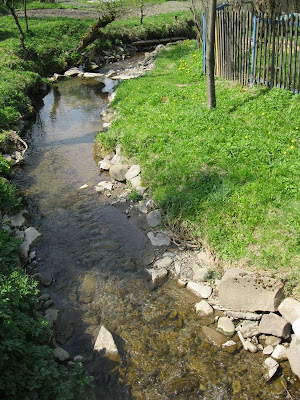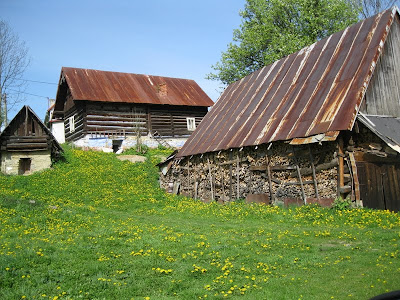Every village we have seen is a unique place with its own particular beauty. Slovak people are thrifty people in so many ways, but in no more obvious way than the placing of homes and villages. In the hill and mountain country, which comprises most of Slovakia with only the south west corner escaping this description, villages are almost always in the very bottom of the valley. A typical design, if you will, has a row of houses up one side of the omnipresent stream, and a row of houses on the other side. The houses themselves are close to each other, very narrow but quite deep. Sixteen feet wide and sixty feet deep is common. The house itself is not that deep, but other attached buildings go back and back. These attached buildings are for wood, animals, equipment and so on. The farmland then lies behind these houses in such a way that the people have direct access to farm and forest and have minimally impinge on either. The stream down the middle of town makes sense in that water is an important asset. As there are villages everywhere in Slovakia, so are there creeks, streams and rivers.
Most of the villages we have visited have a long history as is evidenced by the remainder of many old houses. Slovaks, being thrifty, are huge recyclers, even to recycling houses. Probably one of the really big growth industries in Slovakia today is restoration. In some of the pictures you can see how log houses were covered with mud and the plaster and finally painted. Today the material of choice is block and rock.
Speaking of block and rock, it is the odd Slovak village house that does not sport a pile of wood, a pile of rock, perhaps some block and always a pile of lumber. This is meant in a complimentary way. In the villages where you can view homes from the rear you will see that every Slovak has his "stuff" piled neatly behind his last building. Also, it is rare to find a Slovak village without a church or two. This is the heart and soul of most villages. If you think otherwise, come through on Sunday at church time and see the whole village walking to church, some on two legs, some on three (cane) and some on four (crutches).
We will show you every color imaginable, every style and every state of repair. It is obvious that many people go to the city for their career, retire, come back to the village and build a new home. Most villages sport at least a few new homes and many of these homes are in colors you have to see to believe!
Finally, the Slovaks come out of an agricultural history. While you can't prove it to be genetic, it must run in their blood. It doesn't seem to matter whether one is a doctor, nuclear scientist, pastor or carpenter, all have a garden. Not a hobby garden..... a food-for-the-year garden, replete with an underground storage for fruits and veggies. We have enjoyed last years fruits and vegetables for all of our meals at the relative's house. I asked young Jan, who lives in Kosice (second largest city in Slovakia), if he had a garden. He told me he couldn't have one because he lived in an apartment, but his dad, Jan Sr., supplied the fruits and vegetables for his family. This might help with the picture: Cousin Jan Senior has over one acre of potatoes planted for him and his family. We had chicken yesterday after church. I said to Jan, "We're eating all of your chickens" to which he replied, "no, only seven so far". When we showed up there a week or so later, after the snow here in Zdiar, Jan was down in the mouth as the frost had gotten his potatoes. To put it in perspective, this is a years worth of their staple food. This Sunday we found out that they had survived.
For many city dwellers the opportunity to feed the gardening bug comes in the form of the "huta". The huta contains a small cabin and a small plot of land for the weekender to ply his gardening.
You can take the Slovak out of Slovakia, but you can't change some things. My grandfather, Andrew Rakos of Tacoma, Washington, had his garden out back, his rocks in a pile, his lumber and his wood. He, too, loved bondurkees (potatoes). My brother Andrew of Juneau, Alaska, can be found with the very same cache of goods. Carolyn and I have all but the garden. Too busy traveling in Slovakia to have a garden.
Enjoy the villages, enjoy the color, enjoy the labor of these good folks hands and the blessings of a mighty God.
















































































